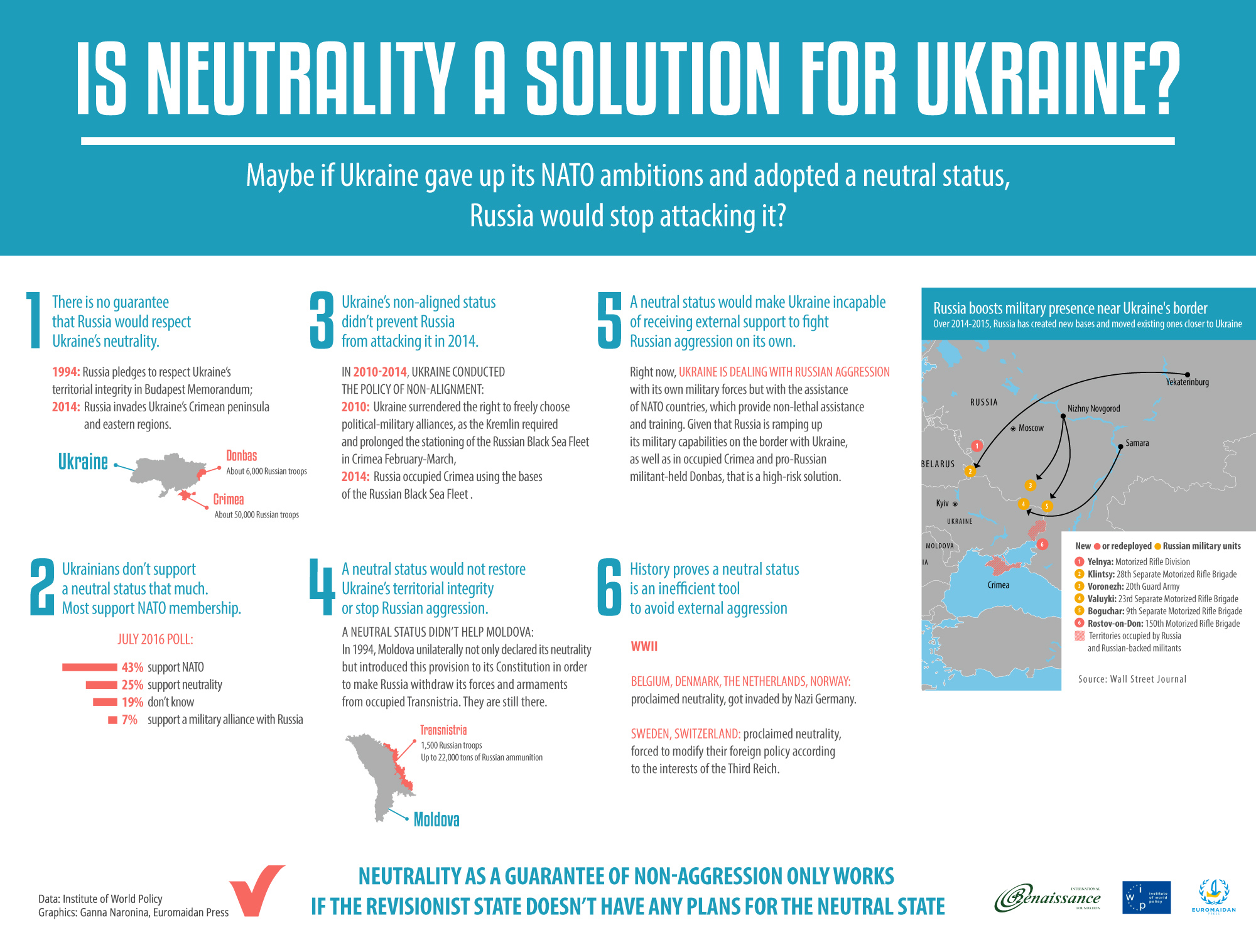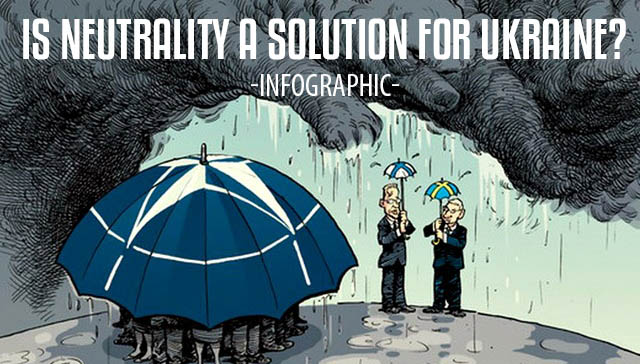In December 2016 on the anniversary of Budapest Memorandum signature, the Institute of World Policy presented its study "Security in Transition. How to Counter Aggression with Limited Resources." Armed neutrality is one of the security models analyzed in the paper. In view of the recurrent interest to the potential adoption of neutral status by Ukraine, IWP presents the main conclusions about the outcomes in case this security model is adopted.

1. There is no guarantee that Russia would observe the neutrality of Ukraine.
Given numerous violations of bilateral and multilateral commitments to Ukraine by Russia, it is highly probable that hypothetic proclamation of neutrality would repeat the fate of the Budapest Memorandum. A neutral status of Ukraine will allow Russia to avoid responsibility for aggression, return access to Western resources, decrease Western attention to Ukraine-related issues, and thus will create all conditions for resumed aggression in different forms.
2. Adoption of a neutral status has no wide-spread support among Ukrainians.
Surveys indicate that option of neutrality/non-alignment of Ukraine is supported by 25% of respondents. That’s why the adoption of a neutrality policy by Ukrainian authorities can instigate not only divisions in society but a domestic political crisis. This, in turn, will cause the security situation in Ukraine to deteriorate, not improve.
3. Ukraine's non-aligned status didn’t prevent Russian aggression.
In 2010-2014 Ukraine conducted the policy of non-alignment (a hybrid status that implies restrictions inherent to neutrality but at the same time doesn’t provide security guarantees associated with it) – unilaterally surrendered its right to freely choose political-military alliances as the Kremlin required without receiving guarantees inherent to neutrality from regional and global powers. Moreover, Kremlin preserved legitimized leverages of influence on Ukraine in the form of the prolonged stationing of the Black Sea Fleet in the Crimea, which should have been impossible if Ukraine had a true neutral status requiring the withdrawal of all foreign military units from its territory. Taken together, all these factors did not prevent Russian aggression but created more favorable conditions for it.
Thus, the idea that if Ukraine adopted a neutral status and gave up Euro-Atlantic integration Russia would be satisfied and end hostilities against Ukraine results from the wrong interpretation of causes and effects of Russian aggression against Ukraine.
4. A neutral status would neither end Russian aggression nor restore Ukraine’s territorial integrity.
Russia wants to achieve not only the guaranteed non-participation of Ukraine in military-political organizations but first of all have a certain level of control over the processes related to Ukraine. The Kremlin is interested primarily in mechanisms to guarantee this status – namely, preservation of de facto or de jure control over the occupied Crimea and some parts of Donetsk and Luhansk oblasts, and through them over the rest of Ukraine. Therefore, the scenario "territorial integrity in exchange for a neutral status" (following the example of Austrian Declaration of Neutrality 1955) is highly unlikely.
Moreover, one should keep in mind that the Kremlin exhausted all the available non-military instruments of influence on official Kyiv in February 2014 and resorted to aggression for preserving its control over Ukraine. In such circumstances, Russia continues with the further militarization of its foreign policy, which is evident by the creation of military infrastructure in 2014-2017 all along the border with Ukraine, and the further militarization of the Crimea and occupied parts of Donetsk and Luhansk oblasts. In result, Kremlin has no other options than to rely on the threat or employment of military force as the major tool of influence on Ukraine.
Besides, the example of Moldova proves that permanent neutrality can neither prevent nor help to cope with consequences of the Russian aggression. Moldova unilaterally not only declared its neutrality but introduced this provision to its Constitution in order to make Russia withdraw its forces and armaments from occupied Transnistria. Kremlin, however, continues to violate the territorial integrity and sovereignty of Moldova.
5. A Neutral status means the inability to receive external support for defense needs.
For example, Ukraine is one of the largest recipients of foreign aid for the defense purposes from the United States. During the first two years since the start of Russian aggression, Ukraine received $ 760 mn for security and defense programs. Adoption of the neutral status by Ukraine would block the possibility to get any assistance and weapons from partners.
6. History proves a neutral status is an inefficient tool to avoid external aggression.
The adoption of neutral status by such countries as Belgium, Denmark, Finland, Netherlands, and Norway during the Second World War did not help them to avoid aggression [Finland had not actually adopted a neutral status, allying with Nazi Germany during WWII - Ed.]. However, even Sweden and Switzerland have been forced to modify their foreign policy according to the interests of the Third Reich.
Moreover, with the end of the Cold War, the policy of departure from strict compliance with this status and enhancement of cooperation with NATO/EU has been gaining popularity among the neutral countries of Europe in order to deal with new security challenges. In the aftermath of Russian aggression against Ukraine, countries such as Sweden and Finland have significantly intensified cooperation with the North Atlantic Alliance and the United States, including through the signing of new cooperation agreements and expanding areas of cooperation.
7. Neutrality as a guarantee of non-aggression works only if the neutral state is not in the interests of a revisionist state.
This assertion is confirmed by the experience of Sweden and Switzerland during World War II, and countries such as Finland, Austria, Sweden, and Switzerland during the Cold War. At the same time, Ukraine has been and remains the 1st priority for Russian foreign policy.
Until Russia continues to view Ukraine as a country within its “sphere of influence,” the adoption of the armed-neutrality security model by Ukraine would lead not to normalization of relations with Russia, but to the loss of Ukraine’s international subjectivity.

